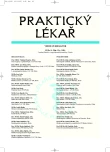Catheter ablation for atrial fibrillation in 2007
Authors:
J. Kautzner
Authors‘ workplace:
Ředitel: MUDr. Štefan Vítko, CSc.
; Přednosta: Prof. MUDr. Josef Kautzner, CSc., FESC
; Institut klinické a experimentální medicíny Praha
; Klinika kardiologie
Published in:
Prakt. Lék. 2007; 87(2): 86-91
Category:
Of different specialties
Overview
Atrial fibrillation (AF) is the most frequent clinical arrhythmia in humans and its prevalence is continuously increasing. Frequent failures of drug therapy have contributed to the development of non-pharmacological methods of treatment. In addition to surgical ablation, several strategies of catheter ablation have been gradually introduced. These consist of the application of radiofrequencies into proximal segments of pulmonary veins, their vestibules and the posterior wall of the left atrium and/or into regions with fractionated potentials. The main goal is to electrically isolate foci in muscular sleeves around pulmonary veins that trigger arrhythmia or to modify a substrate in atrial myocardium, especially in the vestibular regions of pulmonary veins.
There is also a growth in experience with the treatment of chronic AF. The efficacy in curing AF ranges between 70-90 %, according to the population studied, treatment technique, follow up strategy and frequency of follow up visits. Curative catheter ablation for AF has crossed over from the clinical experimental stage and has become standard procedure in selected centres. Novel techniques are being studied in order to make the procedure simpler and faster. Catheter ablation even has the potential to become the first line treatment in many patients with AF.
Key words:
atrial fibrillation, catheter ablation, heart failure.
Labels
General practitioner for children and adolescents General practitioner for adultsArticle was published in
General Practitioner

2007 Issue 2
Most read in this issue
- Risk of malnutrition and nutritional support in Alzheimer disease
- Active search for prostate cancer by PSA testing in GP surgery
- The legacy of I. F. Semmelweis; key milestones in the development of hospital hygiene and current challenges.
- Symptomatic diabetic neuropathy: irreversible nerve damage?
